The Perfect Combination of Brains and Brawn.
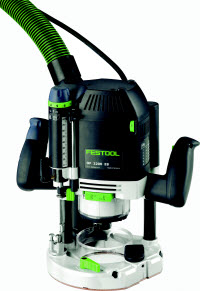
Festool's OF 2200, $1,029, is a big router with a light touch. Weighing in at over 17 pounds, the OF 2200 sports a 3-1/4 hp (18-amp) motor to power through just about any routing task--from deep pocket mortises to heavy molding cuts. But the beauty of this beast is its ability to handle the biggest job with ease and finesse. For example, the depth of cut can be adjusted in increments as fine as 1/256", and the plunge mechanism is silky smooth but locks tight with a lock on each column to eliminate flex. Several ergonomic tweaks make the router's size more manageable. I'll let you know more about those later. Toss in the versatility and time-saving features, and it's plain to see Festool has set a new standard for plunge routers. Of course, a machine like this comes at a price. But, considering the time, effort and hassles this router saves and the quality of design and construction, it puts the price in perspective. Plus, the OF 2200, like all of Festool's products, is part of a large family of interrelated tools designed to work with each other. The value is there for the pro and the serious hobbyist alike.

I put the OF 2200 to work in my shop over the past month. The router always satisfied me. I used it to cut mortises and large geometry edge profiles in wood and to plow dados with Festool's optional guide rail system. The overall design of the router is well thought out and free of the gimmick features and operational hassles I've found in other plunge routers.
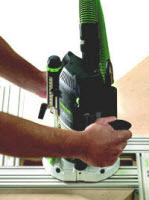
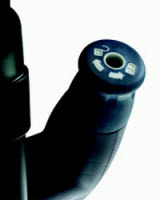
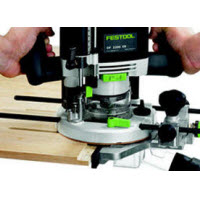
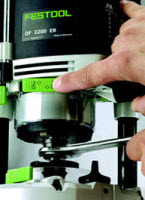

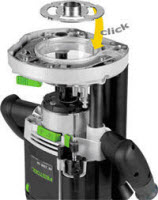
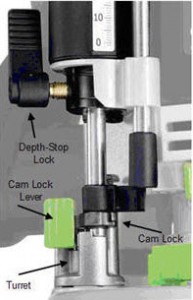
Accuracy and Durability. I’ve already mentioned the 1/256″ precision on depth adjustment, but some other features fall under the accuracy heading. One is the electronic speed control (MMC) that allows infinite rpm adjustments between 10,000 and 25,000 rpm. Once the speed is set, the MMC keeps the bit spinning at its assigned RPM regardless of load. The spinning shaft is held in place by three bearings, one at the top of the shaft, one at the bottom, and one in the middle. The three bearings dampen vibrations and ensure a smooth cut and long router life. It makes for a robust drive system capable of continuous duty in the shop or on-site. There’s a quick-mount fence available as an accessory that attaches to the guide bars with a single lock knob and a micro-adjust knob for the fence. Unfortunately, the fence is not included in the basic router kit.
Dust Collection. Routers are notorious for making mounds of dust and shavings. They are also one of the hardest tools to collect from. Festool has developed the most effective router dust collection system I have seen. Coupled with Festool’s CT 22 vacuum and their 2″ accessory hose, dust collection was nearly 90% on the router I tested. Dust collection dropped to about 75% when I used the smaller 1-in. hose that comes standard with the CT-22.
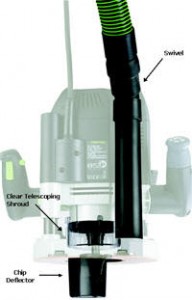
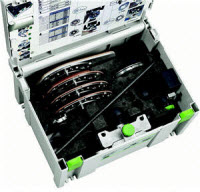
Final Thoughts. This is truly a very fine router. I have to try hard to think of something I don’t like about it. I found it awkward to lay the tool down when the chip deflector is on the base. You can’t set it on the base, or the chip deflector gets in the way. You can’t set it on its back, or the dust collector tube gets in the way; setting it on its face means laying it down on adjustment knobs. I also wish the depth stop gauge was in inches rather than millimeters on the units sold in the U.S.
When looking to purchase the OF 2200 router, consider the Base Accessory Kit as a necessary part of the purchase price. The kit greatly expands the versatility of the router. The Basic Router Kit costs $800 and comes in its own Systainer 4 case. The router has a base plate, an insert for standard guide bushings, a chip catcher, and a 1/2″ collet. The Base Accessory Kit costs another $310 and comes housed in a Systainer 3 case. The Base Accessory Kit includes a parallel edge guide, connecting rods, a dust extraction hood for use with the edge guide, a guide rail adapter, an extra wide support base plate, a guide rail base plate, a small bore base plate, a template guide base plate, plus 1/2″, 3/4″, 1″. and 1-3/8″ guide bushing plates.
Like an expensive car, the Festool OF 2200 is designed for those who demand performance and reliability. The Festool saves so much time and aggravation; it’s worth the extra money. For the pro especially, time is money, and this router will save you time in making adjustments, changing bits, and swapping out base plates for various tasks.


I make much use of Milescraft SignPro lettering. The SignPro needs quite a light touch on a router in order for the router bushing to follow the template edges, avoid deflection of the template frame and minimise risk of the letters jumping. Is the Festool too heavy to use with SignPro?